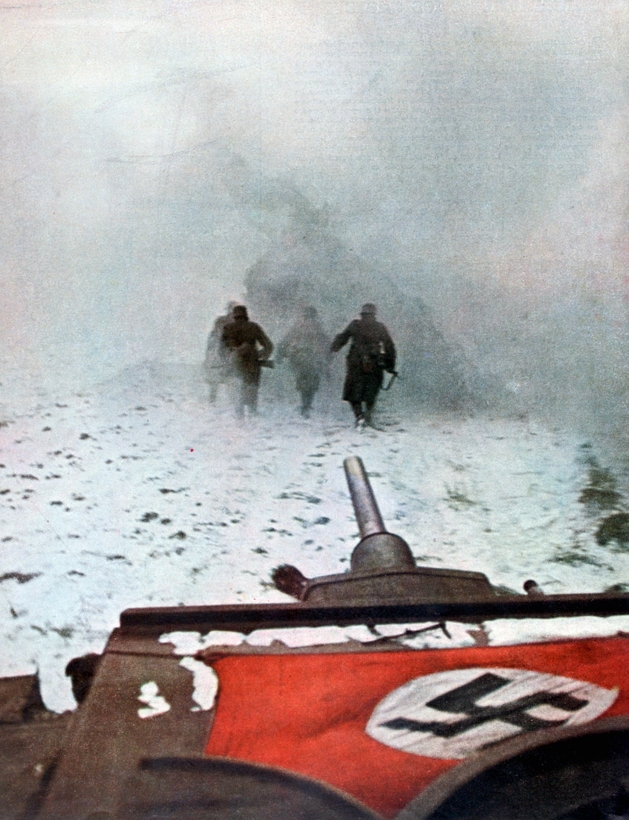The early hours of June 22, 1941, saw the opening of the greatest military operation the world had ever seen. One hundred eighty-six German and Axis divisions—more than 3.5 million men—invaded the Soviet Union, along with 3,350 tanks, 2,000 aircraft, 7,000 field guns, and more than 600,000 horses. To begin with, all went according to plan. Surprised and underprepared, vast swathes of the Red Army were swiftly encircled, and the German panzer divisions were well on their way to their objectives of Kiev, Leningrad, and Moscow by the beginning of July. Hitler’s boast that the Germans had “only to kick in the door and the whole rotten structure [of the Soviet Union] will come crashing down” appeared to be coming true.
But time was marching on. The first snow fell on October 6, and by the time the invaders reached Moscow, having first captured Kiev, the Russian winter was setting in. After ferocious fighting throughout November, the German offensive ground to a halt before the Russian capital.
Barbarossa Re-examined
The Soviet counter-offensive of December 1941–February 1942—in which the Red Army forced the Wehrmacht’s “Army Group Center” back from the gates of Moscow—has traditionally been described as the “first defeat” for the Wehrmacht: a turning point in a war that had known only German triumphs. Not so, says David Stahel in his comprehensive history, Retreat from Moscow. Although few perceived it at the time—certainly not the British nor the Americans who, well into 1942, were predicting a Soviet defeat—the decisive moment actually came in the summer and fall of 1941.
At first glance, this seems surprising. The opening months of Operation Barbarossa (the code name for the invasion of the Soviet Union) produced some of the most spectacular victories in German history. Vast territories were conquered; whole armies captured. Yet by the end of it the Red Army had not been destroyed and Russia remained undefeated. This was the crucial point. Hitler’s plan rested on bringing the Soviet Union to its knees in one swift summer campaign. His failure to achieve this meant not only doom for his Russian adventure but, ultimately, for the Nazi state itself. As the leading German industrialist Fritz Todt explained to the Führer on November 29, 1941: “This war can no longer be won by military means.”
Although few perceived it at the time, the decisive moment came in the summer and fall of 1941.
What, then, is the significance of the German winter campaign of December 1941–February 1942? Although Stahel poses the question in his introduction, he does not provide a direct answer. One obvious justification for this meticulously researched work is the number of myths it explodes—the most fundamental being the claim that the winter campaign represented a strategic victory for the Soviet Union.

Although the Germans were driven back from Moscow, the Red Army only recaptured 35,000 square miles between December 1941 and February 1942—a mere 7 percent of the territory conquered by the Wehrmacht during the preceding months. The losses to Army Group Center—not least due to the ferocity of the Russian winter—were high, but those incurred in July, August, or September 1941 were also considerable.
Hitler’s failure to bring down the Soviet Union in one swift campaign ultimately meant doom for the Nazi state.
More significantly, Army Group Center losses were dwarfed by those of their opponents: the Red Army suffered 552,000 casualties in December 1941, 558,000 in January 1942, and 528,000 in February 1942—1.6 million in total. Considering that Army Group Center suffered 262,524 casualties over a similar period, it is hard to see how this can be viewed as a Russian victory. Soviet losses, thanks to a criminal lack of imagination among Red Army commanders, who ordered repeated infantry charges against heavily defended German positions—were six times greater than German losses.
More important still, the Red Army failed to achieve its strategic objectives. Mimicking Hitler’s mistakes from the summer, Stalin ignored the advice of his generals and insisted upon an offensive across much of the front. Not only was this wildly over-ambitious, it also threw away the opportunity of a Soviet breakthrough by launching concentrated attacks on the weak spots in the German line. Stalin’s aim was to annihilate Army Group Center, yet by the end of the offensive not one division of that formidable mass had been destroyed, and the Germans were entrenched in a defensive line they would continue to inhabit until voluntarily withdrawing in March 1943. It was, as Marshal Georgi Zhukov later acknowledged, “a Pyrrhic victory.”
Between Christ and Hitler
Stahel demolishes the notion that Hitler’s controversial “halt order” was responsible for “saving” Army Group Center. Yet he is equally concerned to understand and convey the experience of individual soldiers and civilians. Unprepared for a winter war—and with it, temperatures that would fall to negative 40 degrees—Army Group Center suffered 90,000 noncombatant casualties during the month of December alone. Amazingly, as Stahel elucidates, both discipline and morale were mostly maintained. But even the professionalism of the German soldier did not prevent the emergence of black and even treasonous humor. “What is the difference between Christ and Hitler?” ran the beginning of one sotto voce joke; answer: “With Christ one died for all.” Goebbels’s winter-clothing drive was widely mocked, while the medal awarded to soldiers who served during the campaign was soon dubbed “the order of the frozen flesh.”
Army Group Center suffered 90,000 noncombatant casualties in December alone.
Not that the Germans were the only ones to suffer. Determined to deny the Red Army either food or shelter, Army Group Center carried out a ruthless “scorched-earth” policy, involving the burning of entire Russian villages, during their retreat. For some German soldiers, the thought of thousands of Russian civilians freezing or starving to death was a cause of unease. For others, dehumanized by war and Nazi propaganda, it was a sadistic form of recreation. “Every day and every night there is skirmishing between us and the Russians,” recorded one German private. “The burning of villages provides delightful relaxation.” Another regretted that the “igniting” was the privilege of “special detachments.”

Stahel has done a vast amount of research, including what must have amounted to months in the German military archives in Freiburg. His arguments are convincing, his prose always lucid. On the debit side, the fact that he is arguing against an interpretation which emphasized the “significance” of this period in the context of the overall war naturally diminishes the importance of his subject. One also wonders whether the general reader will want 560 pages on three months of war on the Eastern Front. Yet this is a serious work of scholarship: a well-argued piece of revisionist history, and a reminder that, for all the misery and slaughter in the West, it was even worse in the East.
Tim Bouverie’s Appeasement: Chamberlain, Hitler, Churchill, and the Road to War is out now


